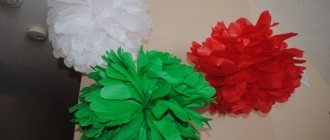L.V. Skrabtsova
1>>
2>> 3>>
Tales of indoor flowers. Golden rules for caring for indoor plants. How to water flowers correctly
Fairy tale for children
AZALEA AND WHITE CAT
In one big city there lived a kind woman. Her name was Maria. Her children grew up and moved away. But she had a cat of amazing beauty - white, fluffy, with huge blue eyes and pink ears. “What a handsome man!” - everyone admired. The cat allowed his silky fur to be stroked, he nodded his head and purred, contentedly: “Pur, pur, pur, you speak correctly.” Yes, the cat in Maria's house was the center of attention. But suddenly everything changed.
It was Christmas Eve, and Maria, having decided to decorate her house, went to the flower shop. There were all sorts of flowers here: multi-colored chrysanthemums, lush begonias, delicate impatiens cyclamens and snow-white gardenias were beautiful, but Mary’s eyes settled on azaleas. “Which one should I choose? White or purple, or maybe pink, with a white border around the edge of the petals? Finally, Maria chose a fluffy pink Azalea with many delicate buds.
They packed the azalea and explained to Maria that this flower loves moisture, bright light and coolness, and can bloom for a very long time. Maria, thanking the owner of the flower shop, happily hurried home.
The pink beauty Azalea illuminated everything around with a gentle, joyful light and, looking at her, I wanted to smile. Friends who came to visit could not take their eyes off her. And they seemed to have completely forgotten about the white cat...
“What injustice,” the offended handsome man grumbled to himself. And when one of Maria’s friends, an old artist, decided to draw a miracle flower, the cat, out of anger, tore a piece of wallpaper from the wall and was punished. Maria threatened that next time she would cut off his claws for such a trick. The cat hid offendedly behind the sofa and did not show itself to Maria for a long time.
But Maria did not forget about her pet cat. It’s just that there had never been such a miracle in her house before, and she tried her best to prolong its flowering. Maria’s care bore fruit, and every week Azalea delighted her hostess with new blooming flowers.
The cat became more and more gloomy. "Who is she? Just a plant. When all her flowers wither, what will remain of her beauty? Nothing,” he reasoned angrily.
One day the cat almost bit off the Azalea flowers. On this day, Maria gently whispered about something to the flower, and then opened the window so that the flower could breathe fresh air. The cat could not stand the winter cold, and a gust of cold wind drove him crazy. “I’m not going to catch a cold because of this princess,” thought the cat, and in one jump he found himself near Azalea. At that moment Maria entered the room. The cat instantly ducked under the sofa. Maria didn’t even have time to notice him. However, the sight of Azalea cowering alarmed her. “I probably over-cooled it,” Maria thought and closed the window. She carefully examined the flower, but Azalea quickly came to her senses, and Maria calmed down.
The cat, watching this scene from under the sofa, was surprised: “But she’s not a sneak! She didn’t give me away, she didn’t complain!”
The next day, when the sun smiled welcomingly at Azalea, a large sunbeam slid along the wall and stopped right above the shelf with ceramic pots. The white cat considered himself the smartest cat in the world, but could not understand that a sunbeam is just a reflection of a sunbeam. Obsessed with the desire to deal with the sunbeam at any cost, he completely forgot about his venerable age and jumped all over the room like a little kitten. And now, he instantly jumped onto the table, then onto the shelf and touched one of the most beautiful pots with his fluffy tail. The pot fell and broke into pieces. The frightened cat was confused, but suddenly heard a gentle voice:
- Hurry up, hide behind my green back!
Azalea watched this whole scene, and she felt sorry for the good-for-nothing handsome man from the bottom of her heart. The cat rushed with all his cat's paws to the flower and hid behind its fluffy branches strewn with flowers. The azalea had grown so much that the cat was completely invisible behind it.
Maria came running at the noise. Not seeing anyone except Azalea, she thought that the wind that blew sharply through the open window was to blame.
When Maria left, the white cat said to Azalea:
“You are the kindest Azalea in the world.” Probably because of your kindness, your flowers do not wither for a long time. Please forgive me.
From that day on, the white cat became friends with the beautiful Azalea and protected her as best he could. Azalea was happy - she had acquired a faithful friend, and what could be more beautiful than this?
>>
Questions and tasks for the fairy tale:
Show children photographs or drawings of azaleas. How do you think azalea differs from other plants? Describe her.
Why do you think Mary liked the azalea the most of all the flowers?
Have you ever come across a houseplant that made you happy?
Do you think the azalea was happy when Mary bought it? Can plants be happy or, conversely, sad about their fate?
Draw an azalea from a fairy tale. What was her character like? What has changed in the white cat thanks to this wonderful plant?
Do you think houseplants and pets can really be friends? Which pets prefer which houseplants and why? Write short stories on this topic.
Teach children about azaleas and how they are grown indoors. Keep a notebook on houseplants and write down basic information about azaleas.
Are only flowering plants attractive? Are there any indoor plants that look beautiful even when they are not blooming?
Fairy tale for children
HOME GARDEN
One day Maria noticed that the beautiful Azalea was sad. “We need to feed her with vitamins, she pleased me with flowers for a long time and probably spent a lot of energy,” Maria decided. But the vitamins did not help, Azalea still looked drooping. Maria became worried and decided to look in books about houseplants for the reason for her poor health. But books didn’t help her either. Then Maria decided to go to a flower shop, hoping that they would advise her on something suitable. The store offered her the same vitamins and a variety of indoor plants. Maria couldn’t resist and bought two of them - the colorful, handsome Croton and the fragile blue-eyed Violet.
“Look who I brought for you, dear Azalea,” she said, entering the room with her new pets, “maybe you will have more fun in their company.”
Imagine Mary’s surprise when the next morning she saw that her Azalea had indeed come to life.
“So this is the medicine my beauty needed,” thought Maria. “She just needed friends who could comfort her so that, no matter what, she would continue to enjoy life.”
So the beautiful pink Azalea began to make friends. And that was very good, because she was still a little sad after she finished flowering.
And Maria, seeing how her favorite smiles when every new flower appears in the house, turned the room into a wonderful home garden, which she herself could not get enough of. Relatives and friends admired the miracle Mary created. Even people indifferent to flowers, when they came to Maria, felt something special in her house, which made their souls feel good and calm. They began to look closely at the flowers and even asked the owner about her pets. At this point, Maria could not be stopped. She talked about flowers with such passion and love that the guests, unable to bear it, asked her for cuttings of any flower they liked. And this flower became the very first in their own home garden.
Previously, Maria knew little about indoor plants, but now, with the appearance of each new flower in the house, she sought to learn as much as possible about it. Sometimes she wondered to herself: “How did I live without flowers before? After all, they help me so much: they console me and make me happy, relieve fatigue and even heal me. If you look at them, all worries go away.” Now Maria always hurried home to her beloved pets. Her joy knew no end when she was given some flower in a pot. Smiling tenderly, she told him: “Welcome, dear flower, to our kindergarten! Don’t worry, you’ll be fine with us!” And the new flower, which until recently was worried about its fate, immediately calmed down and quickly got used to its new family.
Even the white cat got used to flowers and loved them. When a new indoor plant appeared in the house, the cat importantly approached it to introduce itself and licked its green leaves, but under no circumstances bit them.
Yes, the flowers lived a comfortable and cheerful life at Maria’s. She learned to feel her pets so well that without words she understood everything they wanted to tell her. They looked at their mistress with gratitude and filled the house with freshness and beauty. “How lucky we are!” - the flowers whispered, watching Maria take care of them. “It waters us precisely at the moment when we are thirsty; supports us with vitamins when we become weak; opens the window wide when we feel stuffy!”
Maria watered her pets with soft water at room temperature so that the roots did not get cold, and the leaves and buds did not fall off her pets. She loosened the ground so that the roots could breathe easier. When the flower grew and it became cramped in its pot, she transplanted it into a larger pot, adding fresh soil to it. She did not forget to wipe the leaves with a soft sponge, and then the flowers shone and radiated freshness. While caring for the flowers, Maria spoke tenderly to them, questioned them, calmed them down, and even sang songs to them. And how the plants rejoiced when Maria fed them with vitamins - after all, this had a wonderful effect on their tender sprouts! The sprouts grew stronger, the flowers were calm about their own children.
>>
Questions and tasks for the fairy tale:
Show the children photographs or drawings of indoor plants mentioned in the story.
Imagine that one day Maria invited you to admire her garden. Tell us about this visit. Draw Mary's garden.
Do you think a plant is always sad if it is alone? What would have happened to the azalea if Maria had not thought of buying other plants?
Draw a smiling azalea. Have you ever noticed that indoor plants smile? Can indoor plants laugh, worry, worry?
How do you think the plants felt when their leaves were licked by a white cat?
What kind of person should a person be to be able to understand the thoughts and moods of his plants?
What changed in Maria’s life when she got indoor flowers? How can flowers affect a person? Have there been times in your life when indoor plants changed your mood?
How did Maria treat her plants? Why did Maria’s garden look so elegant, since she had never planted flowers before?
What do you think Mary sang to her flowers and what she talked to them about?
Have you ever talked to your houseplants? Do you think plants understand humans?
If you decided to grow a home garden, what plants would be its first inhabitants?
What, first of all, is necessary to make your home garden look elegant? Does it depend on what plants you put in it, or does it depend on other conditions?
Do you think it’s worth learning as much as possible about the life of indoor plants before starting a home garden?
Why do you think some people, having bought just one indoor plant, never decide to start a home garden? What does a person need in order to make such a decision?
Preparatory group
We offer games to consolidate and generalize knowledge about flora, expand horizons, and develop cognitive activity in preschoolers preparing for school.
Make a plant from parts
The game requires pictures divided into parts, each part representing a specific plant organ: stem, root, leaves, flowers. The game task is to create a plant from parts of the picture. It is important that the depicted representatives of the flora belong to different categories: trees, shrubs, herbs, vegetables, flowers.
Didactic game “Groups of plants”
The teacher lays out 4 pictures in front of the players, depicting plants of certain groups. The game task is to identify the extra image.
Here are the categories:
- shade-loving plants - lily of the valley, sunflower, fern, ivy;
- wild - nettle, plantain, burdock, strawberry;
- blooming - juniper, aster, lilac, flax;
- medicinal - chamomile, hawthorn, sedge, coltsfoot;
- poisonous - henbane, clover, crow's eye, castor bean;
- conifers - spruce, pine, cypress, hornbeam.
Vegetable shop
Before the game starts, the teacher tells the children that agricultural crops are taken to vegetable warehouses for storage and to enterprises for processing and preservation. Fruits and vegetables that are stored fresh must be periodically sorted for spoilage. And those fruits that are immediately processed cannot be stored for a long time and quickly rot.
Children are divided into two groups: the first play farmers bringing the harvest, the second play specialists in receiving goods. To play the game you need to make images of different vegetables, berries, fruits, and also put two tables: one will be a vegetable storage, the second will be a processing plant. Each farmer player takes a picture, approaches the goods distributor with it, and he determines where the products will go: to storage or for processing.
Forester
A game played in the forest makes familiarization with plants more effective. The teacher, playing the role of a forester, goes with the children to the forest. This could be a forest belt, a city park. The forester lays out a convenient route for the children, but does not directly tell them where to turn, but describes a tree or bush, followed by a turn. Based on the description of the foliage, the color of the bark, the splendor of the crown and other parameters, attentive preschoolers must guess where to move.
Fairy tale for children
NOBLE IVY
One day Maria learned that flowers such as Ivy, Chrysanthemum, Aloe and Chlorophytum are amazing air purifiers, and she decided to grow these plants in her garden. The first thing she got was a very modest-looking, small and unprepossessing Ivy. No one paid any attention to him in the store, and he was sure that no one would ever need him. But Maria, of all the flowers sold in the store that day, chose this one. At home, she placed the Ivy on the windowsill next to the old Ficus, shining with its dark green leaves. Next to Ficus, little Ivy looked completely puny! But Mary reassured him: “Dear Ivy, soon you will outgrow all the flowers. A little patience!" And Ivy gained strength from these kind words. Indeed, with the onset of spring, he began to grow so quickly that he surprised himself. “Yes, I’m just changing before my eyes, these are miracles!” he thought joyfully. From a frail, inconspicuous bindweed, it has turned into an elegant plant with spreading curved stems, dotted with cheerful leaves, very beautiful in shape. All the spaces between the large leaves were filled with small ones. The leaf brothers were turned towards each other, as if someone had carefully laid out an emerald carpet of them. And the Ivy stems kept stretching and stretching and hanging in different directions. Ivy dreamed of reaching Azalea, who stood on the table near the window. Yes, just to get there, since he had legs - roots with the help of which he could move. These roots are located in Ivy at the very base of the leaves on the back side of the stem and serve Ivy for rapid movement and growth.
When Ivy finally got to Azalea, he touched her with the end of his emerald path and said joyfully:
- Phew, I finally got to you, madam! How are you? You are beautiful and look so young in your new leaves that I can’t help but express my admiration for you.
Azalea, who had recently thrown off her old green outfit, seemed very young in her new soft green dress. A little embarrassed by the words of the kind Ivy, she answered affably:
- Dear Ivy, thank you for your kind words, but now I’m painfully stuffy - the generous sun is baking my new tender leaves so much! I'm afraid they will burn out completely and I won't be able to bloom again. But I don’t want to move away from the window, without light I’ll die! And you, dear Ivy, how do you stand such heat?
“Oh, as for me, I’m very hardy, but I still prefer cool shade.” Who doesn't love it in the heat? - Ivy answered, and then sympathetically added:
- Madam, I am very sorry for you, and I will try to help you. Please be patient for a moment. I will direct all my stems up to the ceiling and give you and all the other flowers a wonderful shade in which you can take a break from the heat!
“I thank you from the bottom of my heart, noble Ivy.” Of course, I will be patient, but can you raise your stems that high?! After all, there are so many leaves on them!
“I’ll try, I have strong muscles!” I was able to reach you! “Once upon a time, even this seemed impossible to me,” Ivy answered and immediately set to work.
He strained with all his might and began to lift the end of the stalk from the table on which Azalea stood to the window frame. It was not easy: Ivy groaned and strained. Tiny droplets of sweat appeared on the stem and began to flow onto the leaves. Finally, with the end of the stem, Ivy managed to lean his elbows on the slippery window glass, and he was able to catch his breath. Then, having gained strength, Ivy walked on the glass again. The window glass was smooth, slippery, and there was nothing to grab onto. With each step of Ivy, a new leaf appeared on its stem, which lengthened the green path directed to the ceiling by one step. Sometimes Ivy’s stem would break and fall wearily, but after resting for a minute, Ivy would pick it up again. So, step by step, leaf by leaf, Ivy stubbornly walked towards his goal.
By evening, Ivy was tired and could no longer move a single leg. But the next morning he woke up before all the flowers and set to work with renewed vigor.
Step by step, leaf by leaf, he stubbornly crawled along the glass with his stems and said to himself: “Just a little more, just a little more, one more step, one more, just to reach the top frame...” He crawled and dreamed about how the flowers will breathe a sigh of relief, joyfully enjoying the shade that he will give them. And most of all he thought about Azalea.
When Maria came in the afternoon and approached her pets with a watering can in her hands, she gasped in amazement, almost dropping the watering can from her hands. The high stems of the Ivy covered the Azalea and other flowers from the scorching rays of the midday sun. The azalea shone with green freshness, as it had once in the winter when Maria first bought it.
Maria understood everything and began to watch with admiration the stalks of Ivy, which from top to bottom covered the entire corner of the window with their delicate green leaves.
The stems of the Ivy were now the first to receive the blows of the hot rays, and through them soft sunlight easily streamed into the room. Geranium, Cyclamen, Decembrist, Chrysanthemum sighed with relief and raised their heads, rustling their leaves gratefully. And Azalea was the most happy. The courageous Ivy gently touched her with its stems, and they whispered about something.
Maria watered the Ivy abundantly and thought: “I need to water it more, because my flowers need it so much!”
>>
Questions and tasks for the fairy tale:
Show the children drawings of indoor plants from the fairy tale.
What plants growing in the field and garden remind you of Ivy? How does the character of Ivy differ from the characters of other indoor plants?
Which indoor plants seem modest in appearance to you? What external features of a plant tell you about its modesty? Are there bullies and braggarts among plants?
Do you think that if Maria had not calmed Ivy down and encouraged him, would he have grown so fast?
Draw Ivy at the very beginning of the fairy tale, and then after he has grown.
What do you think Mary's different plants thought of Ivy?
Choose a houseplant, watch its growth and write the life story of this plant.
Draw a “carpet path” of ivy leaves. Do you know indoor plants whose leaves, like Ivy leaves, are arranged in a path and have legs and roots for movement?
Why do you think Ivy dreamed of reaching Azalea?
Which plants do not tolerate heat well? List these plants. What do you think needs to be done to prevent plants from suffering from heat and stuffiness?
If you were one of the residents of Mary's kindergarten, what would you do to help Azalea? Write a story about it.
Draw Ivy walking courageously on the glass. What helped Ivy grow upward, no matter what?
What do you think Ivy and Azalea were whispering about?
Have you ever noticed that a particular houseplant does something very important and useful for others?
Write a fairy tale about how Mary’s houseplants, in turn, helped Ivy.
Middle group
We present educational and developmental games on the theme “The World of Plants” for preschoolers of the middle age group.
Whose seed is this?
The game teaches you to differentiate cultivated plants and their seeds, improves memory and concentration, and creates cognitive interest. For the lesson, you need recognizable images of vegetables, stone fruits and pome fruits, flowering crops, as well as real corresponding seeds and seeds: sunflower, pumpkin, apricot, cherry, apple, orange, cucumber and others. The game task is to correctly arrange the seeds and pits in the pictures.
What tree are the leaves from?
The game teaches you to identify the external signs of different types of trees. And the main feature is the leaves. For the game you need to prepare pictures of trees and corresponding images of leaves. Or collect and dry real leaves: birch, aspen, rowan, willow, oak, maple and others.
The teacher places stools in a row on the playground. There is a picture of a tree on each seat. The players are given images of leaves. At the starting signal, children run to the stools, look for a tree that matches the leaf, and sit on the seat.
Top or spine
To play you need two hula hoops of different colors, images of vegetables and root vegetables.
You can play in two ways:
- The teacher places the hula hoops on the floor so that they overlap slightly. One color hula hoop is for vegetables, the other is for root vegetables. And in the intersection zone, players must place images of those crops whose above-ground and underground parts are edible. Players take turns taking a picture, putting it in the right place, and justifying their decision.
- The teacher lays out images of tops and roots on the table. Players are divided into two corresponding groups and sort out the pictures. On command, children begin to run and dance. When the signal sounds, each root player must find his pair - the top.
We treat trees
The game fosters a caring and respectful attitude towards natural objects. The teacher and preschoolers go to the park, taking with them boards, pieces of fabric, scissors, cords, and water. There, children examine trees and bushes, looking for diseased specimens: withered, withered, with broken branches. The children’s task is to help the trees, to “cure” them using scrap materials.
Let's make a bouquet
The game teaches you to distinguish and name colors, quickly find a floristic object of a certain type among others, develops creativity, aesthetic taste, and the ability to beautifully arrange fresh flowers in shape and color. For this activity you need cut flowers and separate petals of the same species.
The game consists of 2 stages:
- The teacher lays out petals on the table and places flowers in vases with water. Each student takes turns taking a petal and calling it a color. Then he points to a flower whose petals are exactly the same color and shape.
- Children distribute the presented flowers so that they get beautiful and harmonious bouquets.
Floral ornament
For the game you need autumn leaves of different types of trees. The teacher shows how to lay out a linear ornament, alternating different leaves. Then the students create beautiful plant patterns on their own.
The game can be competitive. Children are divided into 2 teams. Each one creates an ornament according to the scheme presented by the teacher or at her own discretion. In the first case, the team that most accurately and quickly repeated the pattern wins; in the second case, the team that makes a more beautiful and neat pattern wins.
Harvesting
For the game you need pictures of fruits and vegetables. Preschoolers are divided into two teams. The first one harvests vegetables, that is, selects the corresponding pictures. The second one collects fruit. The team that harvests the crop the fastest wins.











